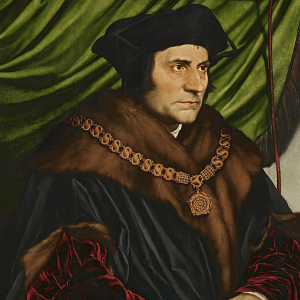
St Thomas More was an English lawyer and statesman who was martyred for his faith by King Henry VIII. He refused to condone the king’s actions in regard to his wife and to the Church.
Read the full St Thomas More novena on the novena page. You can also learn more about novenas here.
Who Was Saint Thomas More?
Thomas More was on February 7th, 1478, in London, England.
His father was a lawyer and judge, and his mother was Agnes Graunger, his father’s first wife (she died, leaving his father a widower).
At age twelve, he came under the service of John Morton, the Archbishop of Canterbury and Lord Chancellor of England. One day, More himself would rise to become Lord Chancellor.
Thomas More studied at Oxford beginning in 1492, Two years later, he directed his studies to law and in 1502 he was able to start legally practicing the profession.
During this time, Thomas More lived near a Carthusian monastery and he sometimes prayed with the monks.
Thomas More married Jane Colt in 1505. They had four children prior to her death in 1511.
More remarried Alice Harpur Middleton, who was herself a widow.
More went on to be elected to Parliament, to become a Privy Counselor, and to write books, including the famous work, Utopia.
King Henry VIII took notice of More, and in 1517 began elevating him: in 1521 he was knighted, then made Under-treasurer of the Exchequer.
Next the king made him Chancellor of Lancaster, and in 1529 Lord Chancellor of England.
The Protestant Revolt was by this time in full swing and had infected England’s shores.
In 1530, King Henry VIII infamously sought an annulment from his wife, Catherine of Aragon, since she had not produced a surviving male heir for him.
Thomas More refused to take part in the annulment request.
Henry VIII began to remove priests loyal to the Pope and the Church, a precursor to his later break from the Catholic Church and his plundering and dissolving of the monasteries.
More tendered his resignation in 1532, unable to go along with Henry VIII’s increasingly schismatic and heretical actions.
The king “married” Anne Boleyn in 1533, which More refused to condone. The king became angry at More’s disloyalty and began seeking accusations against him.
Several trumped up charges against More didn’t stick, but on April 13th, 1534, King Henry VIII demands that More take an oath condoning the king’s schismatic and immoral actions. More refused, so the king had him imprisoned in the Tower of London.
More used his legal expertise to shrewdly remain silent in court against the charges, preventing them from convicting him fully, but several false witnesses came forward and claimed they heard More speak treasonous words against the king.
The biased court sentenced him to be hanged, drawn, and quartered, the conventional punishment for treason.
The king, showing a glimmer of humanity, reduced More’s execution method to decapitation.
More went to his death on July 6th, 1535, famously announcing that he was “the king’s good servant, but God’s first.”
More’s body was buried in the Chapel of St Peter ad Vincula at the Tower of London, in an unmarked grave.
Pope Leo XIII beatified More in 1886, and he was canonized by Pope Pius XI on May 19, 1935.
His feast day is June 22.